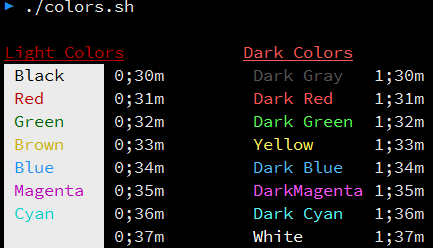Shell scripts commonly used ANSI escape codes for color output. Following table shows Numbers representing colors in Escape Sequences.
| Color | Foreground | Background |
|---|---|---|
| Black | 30 | 40 |
| Red | 31 | 41 |
| Green | 32 | 42 |
| Yellow | 33 | 43 |
| Blue | 34 | 44 |
| Magenta | 35 | 45 |
| Cyan | 36 | 46 |
| White | 37 | 47 |
The numbers in the above table work for xterm terminal.Result may vary for other terminal emulators.
Use the following template for writing colored text.
1 | echo -e "\033[COLORm Sample text" |
The \033[ begins the escape sequence. You can also use \e[ instead of \033[. COLOR specifies a foreground color, according to the table above.The m terminates escape sequence, and text begins immediately after that.
Note: With an echo, the -e option enables the escape sequences. You can also use printf instead of echo.
1 | printf "\e[COLORm sample text\n" |
To print Green text
1 | echo -e "\033[32m Hello World" |
or
1 | printf "\e[32m Hello World" |
The problem with above statement is that the blue color that starts with the 32 color code is never switched back to the regular color, so any text you type after the prompt and even prompt also is still in the Green color.
To return to the plain, normal mode, we have yet another sequence.
1 | echo -e "\033[0m" |
Now you won’t see anything new on the screen, as this echo statement was not passed any string to display. But it has done its job, which was to restore the normal viewing mode. Whatever yor type now will be avoid of any fancy effects.
Escape sequence also allow you to control the manner in which characters are displayed on the screen.
The following table summarizes numbers representing text attributes in Escape Sequences.
| ANSI CODE | Meaning |
|---|---|
| 0 | Normal Characters |
| 1 | Bold Characters |
| 4 | Underlined Characters |
| 5 | Blinking Characters |
| 7 | Reverse video Characters |
Note: Blink attribute doesn’t work in any terminal emulator, but it will work on the console.
Combining all these Escape Sequences, you can get more fancy effect. Use the following template for writing colored text on a colored background.
1 | echo -e "\033[COLOR1;COLOR2m sample text\033[0m" |
The semicolon separated numbers “COLOR1” and “COLOR2” specify a foreground and a background color.The order of the numbers does not matter, since the foreground and background numbers fall in non- overlapping ranges. m terminates the escape sequence, and the text begins immediately after that.Although setting the colors separately also work (i.e. \033[44m\033[32m).
There are some differences between colors when combining colors with bold text attribute.
The following table summarises these differences.
| Bold off | color | Bold on | color |
|---|---|---|---|
| 0;30 | Balck | 1;30 | Dark Gray |
| 0;31 | Red | 1;31 | Dark Red |
| 0;32 | Green | 1;32 | Dark Green |
| 0;33 | Brown | 1;33 | Yellow |
| 0;34 | Blue | 1;34 | Dark Blue |
| 0;35 | Magenta | 1;35 | Dark Magenta |
| 0;36 | Cyan | 1;30 | Dark Cyan |
| 0;37 | Light Gray | 1;30 | White |
The following shell script prints all the colors and codes on the screen.
1 |
|
OUTPUT:

Some examples
Block background and white text
1 | echo -e "\033[40;37m Hello World\033[0m" |
Reverse video text attribute option interchanges fg and bg colors. Bellow statement prints block on white
1 | echo -e "\033[40;37;7m Hello World\033[0m" |
The tput command:
Other than echo there is a command called tput using which we can control the way the output is displayed on the screen.But it is less flexible than ANSI escape sequences.
补充控制选项说明
1 | \033[0m 关闭所有属性 |